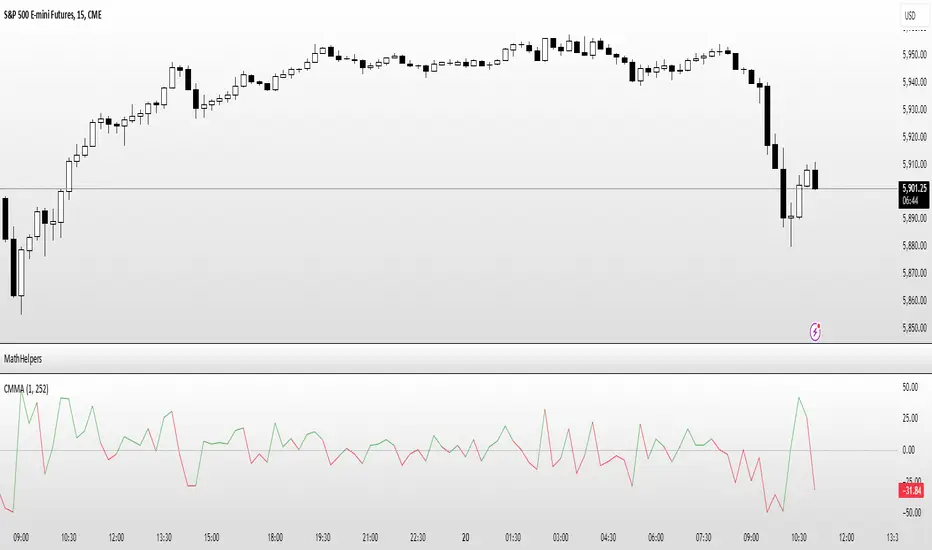OPEN-SOURCE SCRIPT
Close Minus Moving Average

█ OVERVIEW
The Close Minus Moving Average (CMMA) is a statistically robust mean reversion indicator designed to identify potential reversal points in the market. By analyzing the relationship between the closing price and its moving average, CMMA provides traders with actionable insights to enhance their trading strategies.
Important
This indicator requires the use of the MathHelpers library published by HuntGatherTrade
█ CONCEPTS
The CMMA indicator operates by calculating the logarithmic difference between the current closing price and its simple moving average (SMA). This difference is then normalized using the Average True Range (ATR) to account for market volatility. The resulting value is transformed using the Cumulative Distribution Function (CDF) to produce a standardized metric that oscillates around zero.
Key Steps:
Mean Reversion
Mean reversion is a financial theory suggesting that asset prices and historical returns eventually return to the long-term mean or average level of the entire dataset. The CMMA leverages this concept to signal potential entry and exit points based on deviations from the moving average.
█ FEATURES
█ HOW TO USE
Add the Indicator:
Adjust Parameters:
Interpret Signals:
Trading Strategy:
█ LIMITATIONS
█ NOTES
The Close Minus Moving Average (CMMA) is a statistically robust mean reversion indicator designed to identify potential reversal points in the market. By analyzing the relationship between the closing price and its moving average, CMMA provides traders with actionable insights to enhance their trading strategies.
Important
This indicator requires the use of the MathHelpers library published by HuntGatherTrade
█ CONCEPTS
The CMMA indicator operates by calculating the logarithmic difference between the current closing price and its simple moving average (SMA). This difference is then normalized using the Average True Range (ATR) to account for market volatility. The resulting value is transformed using the Cumulative Distribution Function (CDF) to produce a standardized metric that oscillates around zero.
Key Steps:
- Logarithmic Calculation: Computes the natural logarithm of the closing prices.
- Moving Average: Applies a simple moving average to the logarithmic closing prices.
- ATR Normalization: Utilizes ATR to normalize the difference, ensuring the indicator adapts to varying market conditions.
- CDF Transformation: Transforms the normalized difference to a scale that highlights mean reversion tendencies.
Mean Reversion
Mean reversion is a financial theory suggesting that asset prices and historical returns eventually return to the long-term mean or average level of the entire dataset. The CMMA leverages this concept to signal potential entry and exit points based on deviations from the moving average.
█ FEATURES
- Adaptive Normalization: Utilizes ATR to adjust for market volatility, ensuring consistent performance across different market conditions.
- Statistical Robustness: Built upon methodologies from Timothy Masters, ensuring reliable mean reversion signals.
- Clear Visuals: Differentiates positive and negative deviations with distinct color coding for easy interpretation.
- Customizable Parameters: Allows users to adjust lookback periods and ATR lengths to tailor the indicator to their specific trading needs
█ HOW TO USE
Add the Indicator:
- Navigate to the Pine Script editor on TradingView.
- Paste the CMMA script and add it to your chart.
Adjust Parameters:
- Lookback Period: Determines the number of periods for calculating the moving average of the logarithmic close. Default is 1.
- ATR Length: Sets the number of periods for ATR calculation. Default is 252.
Interpret Signals:
- Green Plot: Indicates that the closing price is above the moving average, suggesting bullish momentum.
- Red Plot: Indicates that the closing price is below the moving average, suggesting bearish momentum.
- Zero Line: Serves as a reference point for mean reversion signals.
Trading Strategy:
- Buy Signal: When CMMA crosses above the zero line, indicating a potential upward reversal.
- Sell Signal: When CMMA crosses below the zero line, indicating a potential downward reversal.
█ LIMITATIONS
- Lagging Indicator: As with all moving averages, CMMA is based on historical data and may lag during rapid market movements.
- Parameter Sensitivity: The effectiveness of CMMA can vary based on the chosen lookback and ATR periods. Users should optimize these parameters based on the specific asset and timeframe.
- Market Conditions: Best suited for mean-reverting markets and may underperform in trending or highly volatile environments.
█ NOTES
- Version Compatibility: The CMMA script is written in Pine Script™ version 6. Ensure your TradingView environment supports this version.
- License: This Pine Script™ code is subject to the terms of the Mozilla Public License 2.0. Read the license here.
Mã nguồn mở
Theo đúng tinh thần TradingView, tác giả của tập lệnh này đã công bố nó dưới dạng mã nguồn mở, để các nhà giao dịch có thể xem xét và xác minh chức năng. Chúc mừng tác giả! Mặc dù bạn có thể sử dụng miễn phí, hãy nhớ rằng việc công bố lại mã phải tuân theo Nội Quy.
Thông báo miễn trừ trách nhiệm
Thông tin và các ấn phẩm này không nhằm mục đích, và không cấu thành, lời khuyên hoặc khuyến nghị về tài chính, đầu tư, giao dịch hay các loại khác do TradingView cung cấp hoặc xác nhận. Đọc thêm tại Điều khoản Sử dụng.
Mã nguồn mở
Theo đúng tinh thần TradingView, tác giả của tập lệnh này đã công bố nó dưới dạng mã nguồn mở, để các nhà giao dịch có thể xem xét và xác minh chức năng. Chúc mừng tác giả! Mặc dù bạn có thể sử dụng miễn phí, hãy nhớ rằng việc công bố lại mã phải tuân theo Nội Quy.
Thông báo miễn trừ trách nhiệm
Thông tin và các ấn phẩm này không nhằm mục đích, và không cấu thành, lời khuyên hoặc khuyến nghị về tài chính, đầu tư, giao dịch hay các loại khác do TradingView cung cấp hoặc xác nhận. Đọc thêm tại Điều khoản Sử dụng.